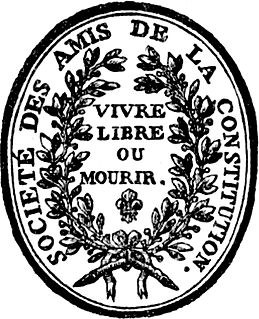Related Research Articles

The French Revolution was a period of radical political and societal change in France that began with the Estates General of 1789 and ended with the formation of the French Consulate in November 1799. Many of its ideas are considered fundamental principles of liberal democracy, while phrases like liberté, égalité, fraternité reappeared in other revolts, such as the 1917 Russian Revolution, and inspired campaigns for the abolition of slavery and universal suffrage. The values and institutions it created dominate French politics to this day.

Rafael Sabatini was an Italian-English writer of romance and adventure novels.

François Barbé-Marbois, marquis de Barbé-Marbois was a French politician.

The royal Flight to Varennes during the night of 20–21 June 1791 was a significant event in the French Revolution in which King Louis XVI of France, Queen Marie Antoinette, and their immediate family unsuccessfully attempted to escape from Paris in order to initiate a counter-revolution at the head of loyal troops under royalist officers concentrated at Montmédy near the frontier. They escaped only as far as the small town of Varennes-en-Argonne, where they were arrested after having been recognized at their previous stop in Sainte-Menehould.

The National Constituent Assembly was a constituent assembly formed from the National Assembly on 9 July 1789 during the first stages of the French Revolution. It dissolved on 30 September 1791 and was succeeded by the Legislative Assembly.

The Society of the Friends of the Constitution, renamed the Society of the Jacobins, Friends of Freedom and Equality after 1792 and commonly known as the Jacobin Club or simply the Jacobins, was the most influential political club during the French Revolution of 1789. The period of its political ascendancy includes the Reign of Terror, during which time well over 10,000 people were put on trial and executed in France, many for political crimes.

Lucie-Simplice-Camille-Benoît Desmoulins was a French journalist and politician who played an important role in the French Revolution. Desmoulins was tried and executed alongside Georges Danton when the Committee of Public Safety reacted against Dantonist opposition. He was a schoolmate of Maximilien Robespierre and a close friend and political ally of Danton, who were influential figures in the French Revolution.

Pierre-Louis Ginguené was a French author.

Antoine de Rivarol was a Royalist French writer and translator who lived during the Revolutionary era. He was briefly married to the translator Louisa Henrietta de Rivarol.

Scaramouche is a historical novel by Rafael Sabatini, originally published in 1921. A romantic adventure, Scaramouche tells the story of a young lawyer during the French Revolution. In the course of his adventures he becomes an actor portraying "Scaramouche". He also becomes a revolutionary, politician, and fencing-master, confounding his enemies with his powerful orations and swordsmanship. He is forced by circumstances to change sides several times. The book also depicts his transformation from cynic to idealist.

Isaac René Guy Le Chapelier was a French jurist and politician of the Revolutionary period.

The Fête de la Fédération was a massive holiday festival held throughout France in 1790 in honour of the French Revolution, celebrating the Revolution itself, as well as National Unity.

François Dominique de Reynaud, Comte de Montlosier, was a notable French politician and political writer during the First French Empire, Bourbon Restoration and July Monarchy. He was the youngest of a large family belonging to the poorer nobility.

Stanislas Marie Adélaïde, comte de Clermont-Tonnerre was a French nobleman, military officer, and politician during the French Revolution.

Louis Charles Auguste Le Tonnelier, Baron de Breteuil, Baron de Preuilly was a French aristocrat, diplomat and statesman. He was the last chief minister of the Bourbon Monarchy, appointed by King Louis XVI only one hundred hours before the storming of the Bastille.

Jean Pierre de Batz, Baron de Sainte-Croix, known as the Baron de Batz or de Bance,, was a French royalist and businessman. He was born in Goutz-les-Tartas (Gers), and died in Chadieu, near Vic-le-Comte (Puy-de-Dôme).

The Society of the Friends of the Constitution, better known as Feuillants Club, was a political grouping that emerged during the French Revolution. It came into existence on 16 July 1791. The assembly split between the Feuillants on the right, who sought to preserve the position of the king and supported the proposed plan of the National Constituent Assembly for a constitutional monarchy; and the radical Jacobins on the left, who wished to press for a continuation of the overthrow of Louis XVI. It represented the last and most vigorous attempt of the moderate constitutional monarchists to steer the course of the revolution away from the radical Jacobins.

Antoine Balthazar Joachim, baron d'André was a French royalist politician.

The Society of 1789, or the Patriotic Society of 1789, was a political club of the French Revolution inaugurated during a festive banquet held at Palais-Royal in May 13, 1790 by more moderate elements of the Club Breton. At their height of influence, it was the second most important club after the Jacobin Club.
References
- 1 2 3 4 Van Laun, Henri (1909). History of French Literature. The Knickerbocker Press. p. 153. Retrieved 2015-12-23.
- 1 2 3 Roudinesco, Elisabeth (1992). Madness and Revolution: The Lives and Legends of Théroigne de Méricourt. Verso. p. 29. ISBN 9780860915973 . Retrieved 2015-12-23.
- 1 2 Mason, Laura (1996). Singing the French Revolution: Popular Culture and Politics, 1787-1799. Cornell University Press. p. 69. ISBN 0801432332 . Retrieved 2015-12-23.
- ↑ Ebert, Adolf (1889). Histoire Générale de la Littérature Du Moyen Âge en Occident, Volume 1. E. Leroux. p. 593. Retrieved 2015-12-23.
- 1 2 Wickham Legg, L. G. (1905). Select Documents Illustrative of the History of the French Revolution, Volume 1. Clarendon Press. p. ix. Retrieved 2015-12-23.
- ↑ Masson, Gustave (1898). La Lyre Francaise. Macmillan. p. 421 . Retrieved 2015-12-23.
les actes des apotres newspaper.
- ↑ Herbermann, Charles, ed. (1913). . Catholic Encyclopedia . New York: Robert Appleton Company.
- ↑ Sabatini, Rafael (1921). Scaramouche. Houghton Mifflin. p. 304, 305, 309. Retrieved 2015-12-23.
Actes.